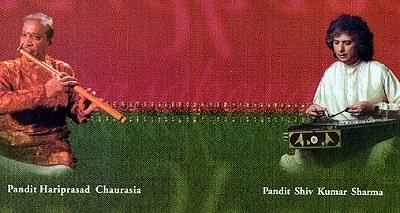Pandit Hariprasad Chaurasia is acknowledged as the pre-eminent Indian flautist, having devoted his entire lifetime to the deceptively simple bansuri (Krishna's instrument), a bamboo flute which he cuts himself from the bamboo groves around his home. The range and subtlety of expression that he draws from this archetypal instrument rivals anything which Western musicians can obtain from Boehm flutes or Stradivarius violins. His studio recordings and contributions to the Nimbus Raga Guide have been recommended previously on Music on the Web.
Pandit Shiv Kumar Sharma plays the santoor, a simple folk instrument of the hammer dulcimer family, which was previously thought uncouth and unsuitable for serious music. He elevated its standing single-handed and could be compared with the achievements of Casals for the cello, Tertis the viola, or Segovia the guitar. Make no doubt, these two Indians are musicians of like calibre.

Their reunion at the Barbican took the form of a long evening of music making with friends, culminating in a joint performance with Chaurasia's nephew Rakesh and Sharma's son Rahul, together with percussionists on tabla and clay pot. There is always heart-warming interaction at concerts of Indian music between the musicians on the platform, and with members of the audience who show their appreciation of the subtleties of performance audibly.
At this concert, the first part was for me the most satisfying. The Chaurasias, uncle and nephew disciple, brought beautiful tone qualities and expressive ornamentation to their playing, close to the human voice, which is the model for all Indian instrumentalists. Amplification seems to be considered unavoidable nowadays for performing Indian music live, and if it is not handled with great care this sometimes distorts the tone. Unfortunately, on this occasion the tabla had an obtrusive metallic sound when it joined in. I have often enjoyed Sharma's astonishing skill on the santoor, but must admit to reservations about the sound of two santoors together, equivalent to the feeling some of us have about two-piano music, or the clatter of multiple harpsichords.
The CDs of the 1997 concert, with the two masters accompanied by pakhawaj
and tabla with the usual supporting tanpura drones, is
very successfully recorded and warmly to be recommended to people who are
unfamiliar with this intriguingly different world of music (rasdhara on
NAVRAS NRCD 0114/5). Even more desirable is Pandit Chaurasia's latest CD
release, an extended ragamala based on Raga Khmaj accompanied
by two of his disciples and Madan Mishra, tabla (NAVRAS NRCD 0116/8).
For details of the extensive NAVRAS catalogue, visit their website
www.navrasrecords.com or request a list by Email:
music@navrasrecords.com
Peter Grahame Woolf
 Return to:
Return to: